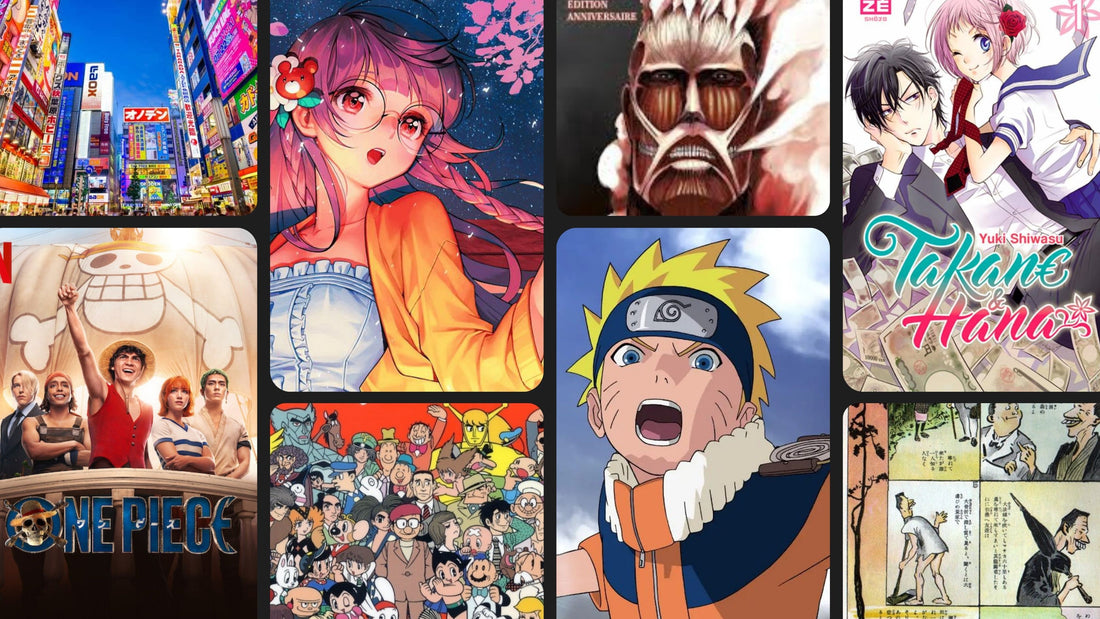Introduction
Manga, the Japanese comics that have conquered the world, are much more than simple entertainment. They are an open window on Japanese culture, reflecting its values, its history and its contemporary concerns. From shonen , aimed at young boys, to shojo , aimed at young girls, through seinen and josei , which are aimed at an adult audience, manga covers an incredible variety of genres and styles. They have become a global cultural phenomenon, influencing not only literature and cinema, but also fashion, video games and many other aspects of pop culture.
The history of manga is rich and complex, spanning several centuries. Although modern forms of manga emerged in the 20th century, their roots go back centuries earlier. Understanding this history allows us to better appreciate the cultural and artistic importance of manga today. Additionally, exploring the evolution of manga allows us to see how it has adapted and evolved with social and technological changes, while remaining deeply rooted in Japanese tradition.
In this article, we'll delve into the origins of manga, going back to the Edo period (1603-1868) where the first forms of Japanese comics began to appear. We will then explore the golden age of manga, which followed World War II, with iconic figures like Tezuka Osamu revolutionizing the medium. Finally, we will examine contemporary manga, their globalization and their global cultural impact.
As the founder of Ikigai Box , I am passionate about Japanese culture in all its forms, and manga holds a special place in my heart. Through this article, I hope to share this passion with you and invite you to discover or rediscover the art of manga. Whether you're an avid manga reader or simply curious to know more, this article will provide you with a comprehensive and fascinating overview of manga history.
Join me on this journey through time and space, discovering manga, works of art that tell captivating stories and reflect the soul of Japan. Let yourself be carried away by the richness and diversity of manga, and perhaps you will find, through them, a new source of inspiration and pleasure.

1. The Origins of Manga
The Edo era (1603-1868)
The origins of manga date back to the Edo era, a period of stability and prosperity in Japan. We also told you about it in our article on the art of Furoshiki . It was around this time that the first forms of Japanese comics began to appear, in the form of prints and cartoons. One of the most famous examples is the work of Katsushika Hokusai, a renowned Japanese artist known for his "Hokusai Manga", a series of sketches depicting scenes from everyday life, landscapes, and fantastical creatures. These sketches, although not manga in the modern sense, are considered precursors to current manga. To learn more about Hokusai and see examples, you can check out this article from Princeton University .
The Meiji era (1868-1912)
With the Meiji Restoration in 1868, Japan opened up to the world and underwent rapid modernization. This period saw the introduction of Western printing techniques and the influence of European and American comics. Japanese artists began to experiment with these new techniques and styles, creating illustrated magazines that combined text and image. One of the pioneers of this era was Rakuten Kitazawa, who popularized the term "manga" and played a crucial role in the evolution of the genre. His works, influenced by Western caricatures, helped establish the foundations of modern manga. Rakuten Kitazawa is also called the "grandfather of manga". Learn more about him in the Japons Infos article .

Drawings by Rakuten Kitazawa
The Taisho era and the beginning of the Showa era (1912-1945)
The Taisho era (1912-1926) and the beginning of the Showa era (1926-1989) mark a period of transformation for manga. During these years, manga became more and more popular with the general public, in particular thanks to the increase in the literacy rate and the diffusion of newspapers and magazines. Publications like "Eshinbun Nipponchi" and "Tokyo Puck" contributed to the popularization of manga as a mass medium. The visual and narrative style of manga continues to develop, incorporating elements of traditional Japanese art as well as Western influences.
In summary, the origins of manga are deeply rooted in Japanese history and culture. From the Edo era to the Showa era, manga evolved, incorporating local and foreign influences to become the rich and diverse medium we know today. This evolution continues, with each new generation of artists contributing to the expansion and transformation of this unique art. In the following sections, we'll explore how manga continued to grow and diversify, becoming a global cultural phenomenon.
2. The Golden Age of Manga (1945-1980)
Post-war and the emergence of modern manga
After World War II, Japan experienced a period of rapid reconstruction and transformation. It was during this period that modern manga began to take shape. Osamu Tezuka , often called the "god of manga", plays a crucial role in this transformation. With iconic works like "Astro Boy" (Tetsuwan Atom) and "Black Jack", Tezuka introduces new storytelling techniques and complex themes that captivate a wide audience. His cinematic style and expressive characters influenced many artists and marked the beginning of the golden age of manga. To learn more about Tezuka's impact, check out the website developed by his fans.

Gender diversification
The 1950s and 1960s saw a rapid diversification of manga genres. The market is growing with publications targeting varied audiences, ranging from children to adults. Shonen manga (for boys) and shojo manga (for girls) are growing in popularity, with dedicated magazines like "Weekly Shonen Jump" and "Ribon". The stories diversify, covering themes from adventure and romance to science fiction and horror. This period also saw the emergence of more adult manga, called seinen and josei , which tackle more mature and complex subjects.
The influence of popular culture and the media
Postwar manga is not limited to the printed page; they influence and are influenced by other forms of media. Adaptations in anime, films and television series help to popularize manga and reach an even wider audience. Series like “Astro Boy,” broadcast on television, play a major role in exporting manga culture abroad. The 1970s saw the emergence of more experimental and artistic manga, with authors like Go Nagai and Leiji Matsumoto exploring new creative territories. To explore this interaction between manga and other media, check out Crunchyroll .
The golden age of manga marks a period of unprecedented growth and innovation. Manga became an integral part of Japanese culture and began to gain popularity internationally. The foundations laid during these years continue to support the manga industry today, influencing new generations of artists and readers. In the following sections, we will examine how manga has continued to evolve and globalize, becoming a worldwide cultural phenomenon.
3. Contemporary Manga (1980 to Today)
The rise of manga in the 1980s
The 1980s marked a turning point for the manga industry. This period saw the appearance of manga that have become classics, such as “Dragon Ball” by Akira Toriyama and “Akira” by Katsuhiro Otomo. These works, along with many other popular titles, are benefiting from the rapid growth of manga magazines like "Weekly Shonen Jump," which are reaching record circulations. In 1989, the circulation of "Weekly Shonen Jump" exceeded six million copies per week, an impressive figure which testifies to the craze for manga in Japan.
The globalization of manga
From the 1990s, manga began to go global, finding passionate readers well beyond Japan's borders. Series like “Sailor Moon” and “Naruto” play a crucial role in this international expansion. Translations of manga into English, French and other languages allow a global audience to discover these works. In 2020, manga sales in the United States reached a record 15 million copies . This international success helps strengthen the cultural influence of manga on a global scale.

Naruto in anime
New trends and digital impact
Contemporary manga continues to evolve, with the emergence of new trends and new formats. The rise of digital technology is transforming the way manga is consumed. Platforms like ComiXology and Crunchyroll allow readers to easily access a vast online manga library. In 2021, the digital manga market in Japan generated more than 342 billion yen (about US$3.1 billion), surpassing sales of print manga for the first time, according to statistics from the Japan Publishers Association. digital manga from Japan .
At the same time, manga covers an ever-widening range of themes and genres. Isekai manga (parallel worlds) and light novels are growing in popularity, attracting a diverse audience. In addition, LGBTQ+ manga and those dealing with social issues are increasingly present, reflecting developments in Japanese and global society.
Contemporary manga are the result of decades of innovation and creativity. They continue to captivate readers of all generations and backgrounds, testifying to the vitality and diversity of this unique art. In the next section, we will explore the global cultural impact of manga and its role in spreading Japanese culture across the world.
4. The Cultural Impact of Manga
The influence of manga on global popular culture
Manga has had a profound impact on global popular culture, influencing not only the publishing industry but also films, television series, video games, and fashion. Iconic works like "Dragon Ball", "Naruto" and "One Piece" have transcended national borders to become global cultural phenomena. In 2020, the global manga market was valued at approximately $4.2 billion, with continued growth expected for the coming years, according to a report from Grand View Research . One Piece was also re-developed in live-action on Netflix.

One Piece live action on Netflix
The spread of Japanese culture
Manga plays a crucial role in spreading Japanese culture overseas. They provide a window into the daily life, values and traditions of Japan, allowing readers around the world to better understand and appreciate this culture. Manga and anime festivals, such as Japan Expo in France and Anime Expo in the United States, attract hundreds of thousands of fans each year, reflecting the global enthusiasm for the art form.
The economic impact
The manga industry is an important component of the Japanese economy. In 2020, manga sales in Japan reached approximately 612.6 billion yen (approximately $5.8 billion), according to a report from Statista . This industry is not limited to book sales; it also includes derivative products, anime adaptations, films and video games. Manga has also boosted tourism in Japan, with iconic sites like Akihabara in Tokyo becoming popular destinations for manga and anime fans.

Akihabara, Tokyo district
Influence on arts and literature
Manga has also influenced arts and literature globally. Many Western artists and authors draw inspiration from the narrative and visual styles of manga to create their own works. From graphic novels to animated series, the imprint of manga is omnipresent. Libraries and universities are increasingly including manga in their collections and curricula, recognizing its artistic and cultural value.
In summary, manga has an immense and diverse cultural impact, touching many aspects of modern life. They have managed to captivate global audiences, while promoting Japanese culture. In the next section, we will explore how this influence continues to grow in the digital age and what the future prospects are for the manga industry.
5. The Manga Industry
The structure of the manga industry
The manga industry is a complex and dynamic sector, comprising various players such as publishers, authors ( mangaka ), pre-publication magazines, bookstores, and digital platforms. Publishers play a central role in financing the production and ensuring the distribution of manga. Major publishing houses like Shueisha, Kodansha and Shogakukan dominate the market, publishing hit titles that sell millions of copies. Pre-publication magazines, such as "Weekly Shonen Jump" and "Weekly Shonen Magazine", serve as a springboard for many manga before their compilation into tankōbon volumes.
The economic impact of manga
Manga represents a significant part of the Japanese cultural economy. In 2020, manga sales in Japan reached approximately 612.6 billion yen (approximately $5.8 billion), according to a report from Statista . The industry is also lucrative overseas, with global manga sales growing strongly, particularly in North America and Europe. Anime, film and video game adaptations also generate substantial revenue, strengthening the economic impact of manga.
The digital evolution
The manga industry has undergone a significant transformation with the advent of digital technology. Online reading platforms and mobile apps, such as ComiXology and Crunchyroll Manga, allow readers to easily access a vast library of titles, often simultaneously with their publication in Japan. In 2021, the digital manga market in Japan generated more than 342 billion yen (about US$3.1 billion), surpassing sales of print manga for the first time, according to statistics from the Japan Publishers Association. digital manga from Japan . This shift to digital has broadened the audience for manga, making these works more accessible to a global audience.
Future challenges and prospects
Despite its success, the manga industry faces several challenges. Digital piracy remains a major concern, impacting the revenues of creators and publishers. Additionally, market saturation and increased competition require constant innovation to attract and retain readers. However, the future outlook remains bright, with rising global demand and growing interest in manga as a form of art and entertainment. Initiatives such as international collaborations and transmedia adaptations continue to drive industry growth.
In conclusion, the manga industry is a pillar of Japanese culture and a global economic force. It has evolved with technological changes and continued to captivate generations of readers. The next section will explore how contemporary manga reflects and influences modern society.
Conclusion
The lasting impact of manga
The history of manga is a rich and fascinating saga that has spanned the ages, evolving from simple illustrations in ancient scrolls and books to a multi-billion dollar industry influencing global culture. From the first historical works to contemporary manga, this unique art form has captured the imagination of millions of readers around the world, while serving as a reflection of Japanese society and its developments. Today, manga is more accessible than ever, thanks to the rise of digital platforms and a growing recognition of their artistic and cultural value.
Growing global influence
Manga is no longer just an exotic curiosity but an integral component of global popular culture. Their influence extends far beyond the printed pages, touching fields as varied as animation, cinema, video games, and even fashion. Events such as the Japan Expo in France and the Anime Expo in the United States demonstrate this global craze, attracting hundreds of thousands of passionate fans each year. Manga has successfully built cultural bridges, facilitating a better understanding and appreciation of Japanese culture.
Future challenges and opportunities
Although the manga industry continues to thrive, it is not without its challenges. Digital piracy and market saturation are ongoing concerns for publishers and creators. However, there are also many opportunities, especially with technological innovation and continued growth in the global market. International collaboration and adaptation of manga into various media forms offer new avenues to reach and engage global audiences.
Join us for more discoveries
The history of manga is far from over, and there are always new works to discover and enjoy. At Ikigai Box, we share your passion for Japanese culture and manga. We invite you to follow us on Facebook and Instagram to stay informed of our latest news and discover our top 6 essential mangas. Join our community of enthusiasts and immerse yourself in the captivating world of manga with us!





1 comment
j’ai pas réussi à deviner c qui le personnage au milieu de la photo, en haut c’est Goku, à gauche, c’est luffy et à droite c’est Naruto.